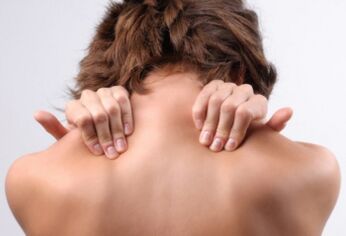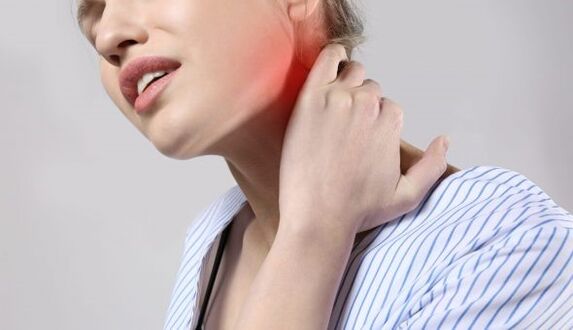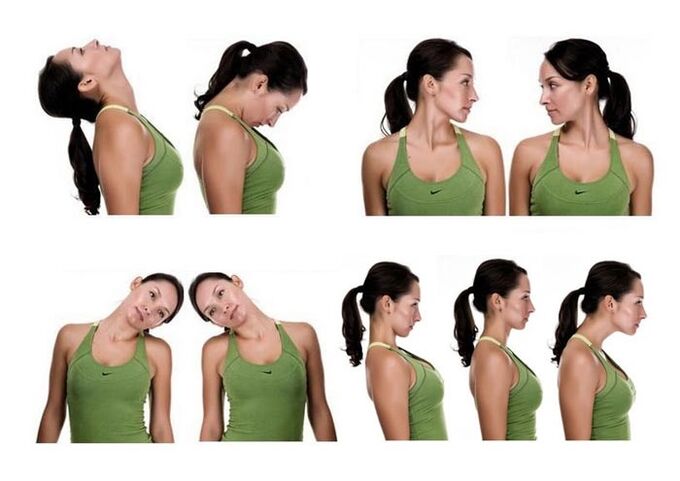
Few modern people have heard of osteochondrosis. Most of them have experienced the symptoms of this disease on several occasions. The widespread spread of the disease is associated with prolonged sitting in front of a computer, a passive lifestyle, poor nutrition, and so on. Osteochondrosis of the cervical spine presents with pain, muscle weakness, limited mobility and many other symptoms.
Do not ignore the signs of osteochondrosis, because the earlier you start treatment, the faster you will get rid of the disease. In the initial stage, conservative therapy is performed: medication, gymnastics, physiotherapy, massage, etc. If complications occur and the bone-cartilage structure is destroyed, surgery is prescribed.
Which
Osteochondrosis of the neck is a pathology that occurs only in humans. Animals do not suffer from it. This is due to the vertical position of the spine. In this situation, the vertebrae compress each other, leading to the fact that the intervertebral discs are gradually destroyed.
The cervical region consists of 7 vertebrae separated by plates. This section of the spine is quite mobile, making it one of the most vulnerable areas of the spine. The weakest link in the cervical spine is the intervertebral disc, which primarily reflects degenerative-dystrophic lesions.
The occurrence of osteochondrosis of the neck is also explained by the weak muscle ligament of the neck. In addition, there are small vertebrae in this area, different structures and too close together. This is why even a small load on the neck can provoke their displacement and compression of blood vessels and nerve branches. When the vertebral artery is pinched, which is located in this area of the spine, dangerous complications occur.
Osteochondrosis (CS) of the cervical spine threatens with protrusions (displacement of the nucleus pulposus without damaging the outer shell) and disc herniation. These formations compress the nerve bundles, the blood vessels.
Due to the degenerative changes in the intervertebral discs, the likelihood of bone growth (osteophytes) in the areas of the joints of the vertebrae increases. As a result, the intervertebral canal narrows and neurovascular formations are compressed.
Reference. According to medical statistics, people over the age of 35 are more likely to suffer from cervical osteochondrosis. Although the pathology that often develops in patients over the age of 20 is now rejuvenating. This is due to a predominantly sedentary lifestyle and malnutrition.
Doctors have identified 4 stages of the pathology:
- 1 degree - the cartilage lining between the vertebrae begins to collapse. At this stage, the disease cleared the symptoms. Unfortunately, patients do not notice them.
- 2 degrees - under the pressure of the vertebrae, the height of the plate decreases, the integrity of the outer shell is damaged. Highlights may appear at this stage. Pain occurs, neck mobility is limited, and facial sensitivity may be impaired.
- Grade 3 - The protrusions become hernias that contract the blood vessels and muscles. In addition to pain syndrome, there is pain in the back of the head, dizziness.
- 4 degrees - osteophytes are formed that stabilize the vertebrae but pinch the nerve fibers. The pain does not go away, stiffness occurs, the adjacent vertebrae are damaged, and neurological symptoms occur.
It is important that the treatment is described in 1-2. start with to avoid serious complications that can only be corrected with surgery.
Cause
Osteochondrosis SHOP is a complex and lengthy process that can occur due to a number of negative factors.
For example, in the elderly, the disease is associated with age-related changes in the body. Degenerative-dystrophic changes then occur due to local blood circulation, disruption of metabolic processes, and weakening of immunity.
However, doctors have identified the main causes of cervical osteochondrosis:
- Bad posture.
- Curvature of the spine.
- Injuries to the neck segment.
- Overweight.
- Tired physical work.
- Prolonged sitting in front of a computer.
- Passive lifestyle.
- Violation of metabolic processes.
- Frequent hypothermia of the neck.
- Improper layout of the sleeping area (mattress too soft, high pillow).
- Frequent stress, chronic fatigue.
- Congenital pathologies of the SHOP structure.
- Autoimmune diseases that cause cartilage degeneration.
- Infections.
- Characteristics of body parts such as the very long or short neck.
These factors cause damage to the intervertebral structures, bone tissue, and damage to the nerve bundles and blood vessels.
Symptoms
The clinical picture of cervical spine osteochondrosis (OSHOP) is diverse. This makes it difficult for patients to understand what is happening to them. Early manifestations of the disease are attributed to overload. And after the onset of the pronounced symptoms, they rush to the doctor, but in this case there are already irreversible changes and the structure of the cervical spine can no longer be restored.

The main symptoms of osteochondrosis of the cervical spine are:
- Painful feelings in the neck and shoulders.
- Weakening of the muscles surrounding the affected segment of the spine.
- Excessive sweating.
- Violation of sensitivity of upper limbs.
- Movement coordination disorders.
- Cefalalgia (headache).
- Dizziness (dizziness).
- Hearing and vision problems.
- Increase in blood pressure, etc.
The nature of headache in osteochondrosis is different: paroxysmal, persistent, pulsating, dull. This symptom is due to spasms of the cerebral vessels, compression of the nerve bundles in the cervical spine, and increased intracranial pressure.
With OSHOP, pain does not always appear in the neck segment and can spread to the shoulders and arms. You may experience discomfort after sleep, sudden movements, or neck tension such as coughing or sneezing.
With osteochondrosis of SHOP, pressure elevations can be observed depending on the time of day, constant hypertension is not characteristic of the pathology. Generally, with increasing pressure, the following manifestations are observed: cephalalgia, hand pain, numbness of the neck-collar zone. A drop in pressure is often observed after nervous or muscular tension after prolonged discomfort.
Cervical osteochondrosis syndromes
There are a number of syndromes in OSHOP (typical conditions accompanied by characteristic symptoms). Their manifestation depends on which nerve branches and blood vessels are damaged.
Cervical osteochondrosis syndromes:
- Arterial vertebrae - caused by compression or irritation of the artery that feeds the brain. The patient will then experience hearing loss, vision, dizziness, pressure drop, migraine, and so on.
- Heart - occurs when the nerve bundles that innervate the diaphragm or pectoralis muscle are compressed. Then there is burning pain in the chest, shortness of breath, weakness, increased heart rate.
- Hypertension - caused by compression of the veins, which causes the blood to flow out of the head. Then the intracranial pressure rises, the patient suffers from cephalagia, nausea, vomiting.
- Cervical migraine - occurs due to compression of the nerves surrounding the vertebral artery. Then there is painful migraine-like pain in the back of the head. The seizure lasts for about 10 hours and is often accompanied by an outbreak of vomiting.
- Radicularis is the most common syndrome in OSHOP. It is caused by the compression of one of the nerve bundles in the vertebrae of the cervical segment. If the conduction of 1-2 roots of the cervical vertebrae is damaged, tenderness is disturbed or pain occurs in the back of the head. If 3 pairs are injured, the tongue, the area behind the ear becomes numb, it is difficult for a person to chew food. Inflammation of 4 pairs of roots is associated with collarbone pain, hiccups, and difficulty swallowing. If the conduction of 5-8 pairs of nerve bundles is disturbed, the patient will have difficulty moving his arm.
Reference. Often, osteochondrosis of the cervical spine manifests itself in multiple syndromes, making the diagnosis difficult. Therefore, you should not guess alone, it is better to consult a specialist.
Establishing the diagnosis
If you do not know what to do if you experience suspicious symptoms, it is better to contact a therapist immediately. If necessary, the doctor will refer you to an orthopedic, vertebrologist, neurologist.
The following instrumental tests are used in the diagnostic search:
- Radiography.
- Computed tomography or magnetic resonance imaging.
- Electroneuromyography.
Each of the above studies provides some information about the cervical spine. For example, X-rays, CT, MRI are used to detect pathological changes in the structure of the spine. Electromyography allows the condition of nerve bundles to be assessed.
Radiography in different projections can be used to detect the accumulation of calcium salts, a decrease in the height of the cartilaginous spacers between the vertebrae, deformation of the CS, the presence of bone outgrowths, and so on. .
Treatment
OSHOP therapy should be comprehensive. The choice of technique is decided by the doctor, taking into account the stage, form and severity of the symptoms.
Treatment of osteochondrosis of the cervical spine is long and complex. It is unlikely that the pathology will be completely cured, especially if it is an elderly patient. However, degenerative-dystrophic disorders of the cervical segment can be stopped at any stage.
In the early stages of the disease, conservative methods are used: medications, physiotherapy, physiotherapy procedures, massage, orthopedic devices. Most of the above methods can be used at home.
In stages 3-4, which involve the destruction of not only the cartilage but also the vertebral bodies, surgery may be required.
The following medications help get rid of pain, inflammation, relax tense muscles and improve the condition of cartilage tissue:
- Analgesics. If the pain is severe, taking painkillers can help you. For the same purpose, NSAIDs are used to cope not only with pain but also with inflammation.
- Steroids stop inflammation and pain. For this purpose, drugs based on glucocorticoids are used in the form of tablets or ointments.
- Muscle relaxants help relax the cramped muscles around the affected area. Solutions for glycerol or benzimidazole for parenteral administration are used for this purpose. They normalize muscle tone and relieve pain.
- Anticonvulsants help to overcome pain and muscle cramps.
- Vitamins speed up the recovery of the nervous system. For this purpose, drugs are taken based on the elements of groups B, A, C, D, E. Vitamin-mineral complexes are quite effective.
Reference. If the pain syndrome is very severe and oral painkillers do not help, your doctor may prescribe therapeutic blockade. Injections containing anesthetic or steroid solutions are directly the focus of the pathology. This procedure should only be performed by an experienced technician.
As part of the complex therapy, anti-inflammatory, warming and analgesic creams, gels and ointments are used.
Therapeutic exercises are prescribed to alleviate the condition of patients and improve their physical fitness. Exercise helps strengthen the muscles around the neck, improves metabolic processes, speeds up blood circulation, and relieves stress on a weakened spine.
Gymnastics is especially popular in OSHOP, which is usually performed in the gym using special simulators. However, if you want, you can also practice at home.

Practical therapy complex for cervical osteochondrosis:
- Gently tilt your head over your shoulder, secure for 30 seconds, and then repeat the movement in the other direction.
- Tilt your head forward, trying to touch your chin to your chest, then lift it up and forward slightly.
- Lower your head slightly back, turn to the right and then to your left shoulder.
- Press your left shoulder with your right hand, raising your elbow slightly. Then turn your head to the right, stay away, feel the muscle tension.
- This exercise is performed as a third, only when you turn your head, raise your arms above your head, and secure them.
- Put your hands on your knees, split them, try to connect the shoulder blades, while lifting your chin. So he develops the chest region.
- Get up, lower your arms, stretch your neck forward, try to touch your chin to your shoulder.
Before training, you need to do a warm-up together and take a shower to relax your muscles. Stretch after completing the complex.
You can treat osteochondrosis of the neck with physiotherapy:
- UHF.
- Laser therapy.
- Magnetotherapy.
- Electrophoresis with drugs, etc.
Magnetic therapy relieves inflammation and pain. UHF and laser treatment speeds up the metabolism in the affected area, helping to eliminate bloating. Thanks to electrophoresis, drugs penetrate the skin into the inflammatory focus, where they immediately exert their effects.
With the help of the massage, the muscle tone is normalized, the blood flow to the injured area is accelerated, and the trophism of the tissues is improved. After completing the course, which usually consists of 10 procedures, the development of degenerative-dystrophic processes in the cervical spine stops.
You can use a needle applicator at home - it’s a plastic device with a large number of pins. You must lie down on the device or apply it to the affected area. The applicator helps relieve pain, relaxes muscles, improves blood circulation and movement.
The Shants collar is used for severe pain. This orthopedic device locks the neck in place, reduces the load on the vertebrae and relieves pain.
With complex treatment, the patient can get rid of degenerative disc disease of the neck forever. However, this is possible if the disease was detected in stage 1. In other cases, complex measures help stop the pathology from developing.
Chondrosis of the cervical spine
Many people believe that chondrosis and osteochondrosis are a disease. However, this view is wrong. In the first disease, only the cartilage lining of the vertebrae is damaged, in the second, degenerative lesions spread to the bone tissue. That is, chondrosis is the first stage of osteochondrosis.
Chondrosis of the cervical spine develops when the metabolic processes in the intervertebral disc are interrupted. At this point, the collagen fibers are replaced by useless fibrous tissue, and the hyaline cartilage becomes calcified and less elastic. Its height decreases, which impairs the function of the vertebrae.
The causes of chondrosis and osteochondrosis are not different.
Cervical chondrosis has the following symptoms:
- Rapid fatigue of the muscles surrounding the SHOP.
- Bad posture.
- Recurrent discomfort or mild pain in the affected area.
- Limited neck mobility.
Patients usually do not notice the symptoms of chondrosis. The disease is discovered accidentally by X-ray or MRI.
Treatment of chondrosis
The treatment plan for cervical chondrosis is slightly different from the tactics for treating osteochondrosis. For the first disease, doctors prescribe NSAIDs and chondroprotectors. In addition, the patient should avoid excessive physical exertion or prolonged sitting. It is recommended to perform therapeutic exercises, eat correctly, give up bad habits.
Other methods of treatment include massage and manual therapy. In addition, physiotherapy procedures are indicated, such as electrophoresis, ultraviolet radiation, amplipulse therapy, diadynamic therapy, balneotherapy, sludge treatment. Acupuncture (acupuncture) has been shown to be effective in treating chondrosis.
Opinions
In most cases, patients manage to get rid of the symptoms of cervical osteochondrosis for a while and then the disease returns. This is usually because the patient is seeking medical help late or is not following the doctor's recommendations during treatment. But there are those who have managed to cure OSHOP and no longer face its symptoms.
- "Neck osteochondrosis was diagnosed in 2 stages. Doctors prescribed anti-inflammatory tablets and injections. After the pain was over, I started going for a massage, did special exercises, and used a medicated ointment. I felt considerable relief after the cure. After 3 months, however, the neck pain reappeared. Therefore, the course had to be started from scratch. "
- "I have been living with cervical osteochondrosis for a long time. Sometimes I visit a chiropractor who adjusts the vertebrae. But most of all, physiotherapy exercises help. The doctor recommended very effective exercises that I try to do every day. But as soon as I miss a few hours, the pain starts again. "
- "It is quite treatable in the early stages of cervical osteochondrosis. That's what happened to me. First, doctors prescribed anti-inflammatory therapy that relieved pain and inflammation. The treatment was then supplemented by gymnastics, massage and acupuncture. In addition, I visited the pool, started taking vitamins and eating right. To forget the pain forever, I had to completely change my life. It’s not a day without special exercises, but the plus is that nothing hurts and my physical fitness has improved. I haven’t felt back pain in a long time and I continue to lead a healthy lifestyle. "
Main conclusions
Osteochondrosis of the cervical spine is an insidious disease that manifests itself in a variety of symptoms. The patient does not always understand what is really happening to him. And when severe pain occurs, rush to the doctor, but this sign indicates the presence of degenerative-dystrophic lesions of the cervical segment. In this case, the condition of the spine cannot be restored. Treatment is then given to help stop the pathology from developing and to avoid serious consequences. Osteochondrosis therapy is a complex and lengthy process that requires patience and organization. After eliminating pain and inflammation, the patient should exercise regularly, participate in massages, physiotherapy procedures, use orthopedic devices, eat right, and give up bad habits. Monitoring a healthy lifestyle, moderate physical activity, weight control, and posture control are important. Only then can you stop the pathology and live a full life.


















































